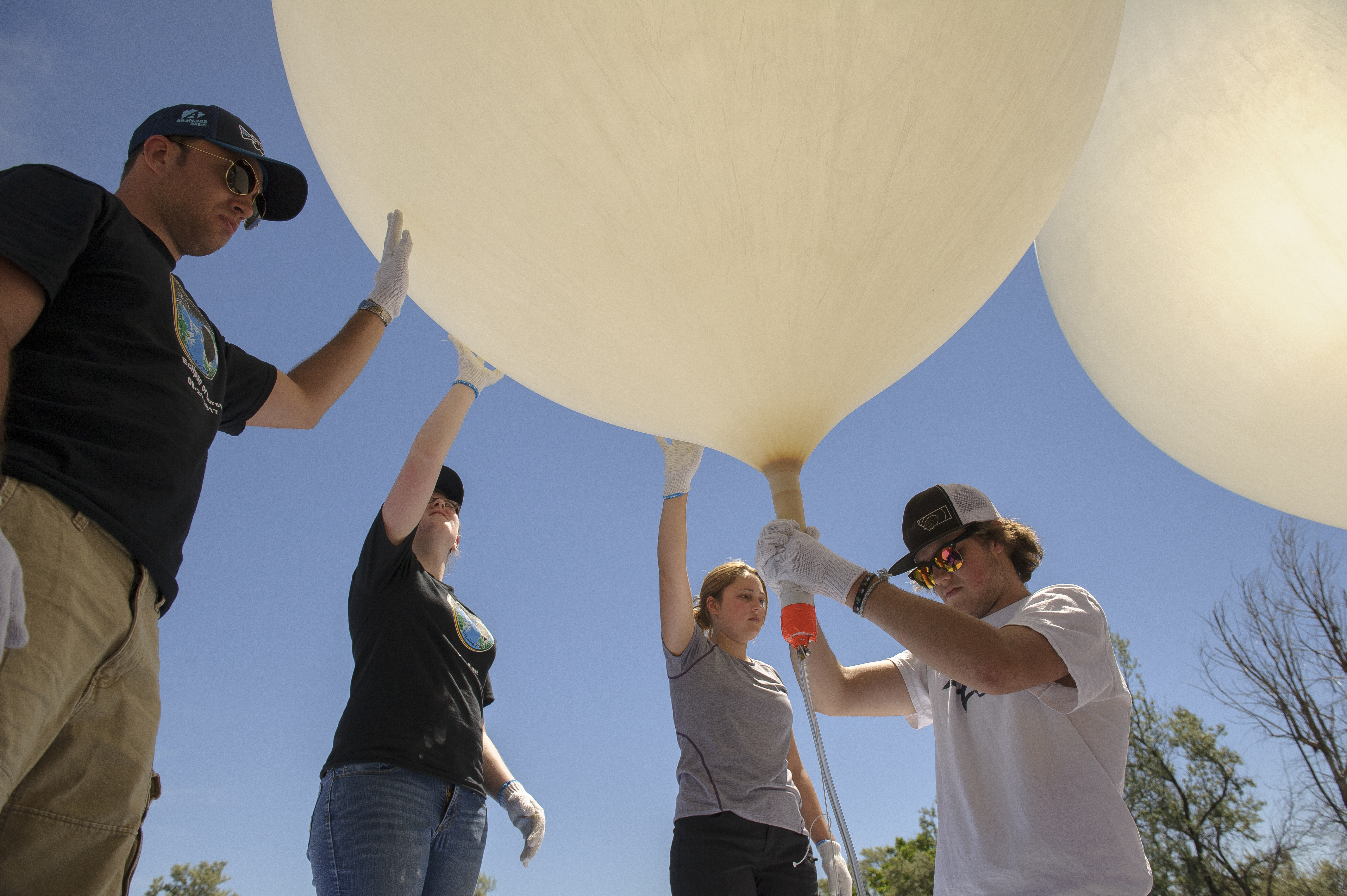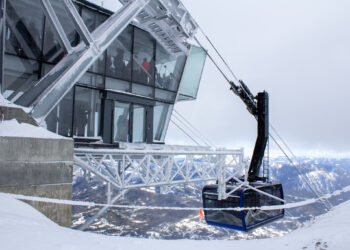By Marshall Swearingen MSU News Service
REXBURG, Idaho – When a half-dozen Montana State University engineering, computer science and physics students tromped off-trail in the foothills of the Teton Range in late June, they were one step closer to providing millions of people a unique view of August’s rare solar eclipse.
They swatted mosquitoes as they searched for cameras, tracking devices and other equipment that had dangled beneath a parachute before landing on national forest land. Prior to that, the equipment had been hoisted by a large helium-filled balloon to an altitude of more than 80,000 feet.
The balloon launch was one of the final test flights for the MSU-led Eclipse Ballooning Project. During the Aug. 21 eclipse, 55 teams from across the country will live-stream aerial video footage showing the moon’s shadow crossing North America, the curvature of the Earth and the blackness of space.
“The goal [with the test flight] is to get practice filling the balloons with helium and timing the launch so that the balloons reach altitude at the right time,” said Randy Larimer, deputy director of the Montana Space Grant Consortium and an adjunct instructor in MSU’s Department of Electrical and Computer Engineering.
During the eclipse, timing will be paramount because the period of totality, when the moon entirely blocks the sun, will last only about two minutes. That’s when the Eclipse Ballooning Project teams want to have their rapidly rising balloons at about 80,000 feet to capture the best view.
Most of the 15-person team had risen before 4 a.m. to make the 180-mile drive from Bozeman. In Rexburg, half of the team assembled dish-shaped radio receivers and other equipment for tracking the two balloons from a corner of the small Rexburg airport. The others loaded tanks of helium in a pickup and drove about 20 miles west to launch the balloons from the Camas National Wildlife Refuge.
Sara Stafford, a junior from Fairbanks, Alaska, who is majoring in electrical engineering, selected the launch site based on flight-path predictions she calculated from current wind data. “We don’t want to land in the mountains or in the city,” she said.
Around noon, the launch team readied each balloon’s cargo, or payload—a trio of shoebox-sized enclosures connected with parachute cord—and unrolled the balloons on tarps to begin filling them with helium. The balloons, tugging on their ballast, grew to more than 8 feet tall.
“It’s a little bit of an art getting the right amount of helium,” Stafford said as she worked the valves on the tanks.
Then “10 … nine … eight … ” went the launch countdown, until the balloons shot skyward at a rate of more than 12 miles per hour.
“That went pretty smoothly,” Stafford said.
The action shifted back to the Rexburg airport, where MSU engineering and computer science students crowded around laptops under a tent awning in what looked like an improvised NASA control center. As the balloons came into range of the receiver dishes, the team watched live video showing the Tetons and a patchwork of planted fields.
“Are you looking for UFOs or what?” said a man walking to a nearby aircraft hangar.

Garcia with the Eclipse Ballooning Project monitor signals from high-altitude balloons during a test launch
June 22 in Rexburg, Idaho. The MSU team is leading an effort to live-stream video of the total solar eclipse
in August.
The team pointed to the balloons—visible specks even at 80,000 feet because they grow to roughly 50 times their original size in the stratosphere’s low pressure—as they drifted slowly overhead.
As the specks continued east, the team tested the limits of the system that transmits the video. Using algorithms programmed by the students, the radio receivers automatically pointed at the balloons using GPS data from the balloon and the ground station in order to receive the signal.
“If we’re only two or three degrees off, we lose half our signal strength,” said David Schwehr, a senior from Billings who is majoring in computer science and who played a leading role in developing the balloon-tracking system.
Schwehr, watching the balloons’ coordinates on a laptop, saw when the first, and then the second, popped at around 90,000 feet due to the low atmospheric pressure. In the event that the balloons didn’t naturally pop, each was equipped with a backup system to mechanically release the payload in order to prevent the balloon from carrying it long distances.
As the payloads dropped and the parachutes unfurled, the wind continued to carry them east, toward the Tetons.
The jet stream wind was proving to be stronger than predicted.
Schwehr saw one of the small balloon-shaped icons, charting a path on a Google map displayed on his laptop, turn green. A payload had landed on open ground west of the Tetons.
The other kept going. “We’re almost into Wyoming,” Schwehr said.
When the balloon finally landed, the team plotted a route on Forest Service roads to retrieve it.
“I’m happy with today’s flight,” Schwehr said as the team packed the equipment into crates. The timing of the launch to reach the desired altitude at a specified time went according to plan, he said. And the team verified that the radio transmission systems were working as they should.
About half the team drove toward the rugged, snow-capped peaks of the Tetons. Highway turned to narrow back roads threading through aspen forest.
That’s where the mosquitoes entered the story, swarming the students as they hopped from the trucks and headed off-trail. Schwehr, with a hand-held GPS, guided the group toward the payload as the evening sun filtered through lodgepole pines.
“I found it!” one of them shouted. The small camera enclosures and other equipment lay tangled in parachute cord in the brush, but everything was mostly unscathed by the landing.
The hike to the trucks and the long drive back to Bozeman lay ahead, but the team seemed unfazed.
“It’s incredibly rewarding … to watch these students grow,” Larimer said. “These students are going to have experiences that they can’t replicate anywhere else.
“It’s going to be the first live video from a balloon during a solar eclipse,” he said. “That’s way cool.”















